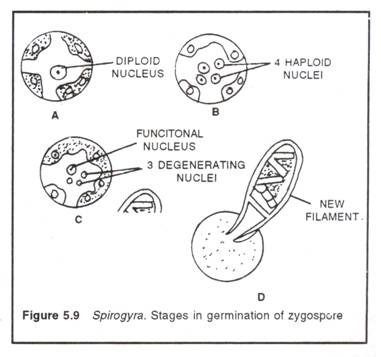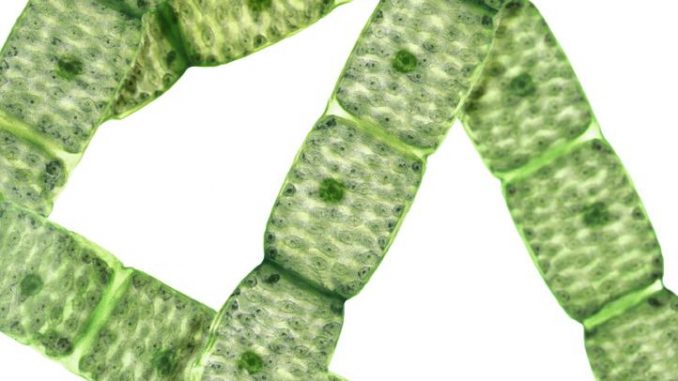
Spirogyra
- Spirogyra is a green algae belonging to the class chlorophyceae. The genus Spirogyra comprises more than 300 species and most of them are free floating algae. However, some species like S. rhizopus, S. dubia etc are found attached to substratum by the means of rhizoids.
Habitat: they are commonly found floating in fresh water resources like ponds, lake, ditches etc. and some are also found in slow running stream or river.
Structure of Spirogyra
- The vegetative structure or plant body is known as thallus. Thallus is a unbranched multicellular filamentous structure formed by arrangement of cylindrical cells head to head in a single row.
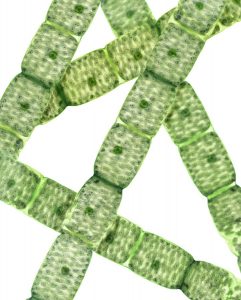
Figure: thallus of Spirogyra
Each cell is covered by cell wall. Cell wall is double layered, outer layer is made up of pectin and inner layer is made up of cellulose. Exterior to the cell wall, there is layer of mucilaginous sheath which make the organism slippery. So, they are commonly called as water silk as they are slimy in nature. The protoplasm consists of plasma membrane, cytoplasm, nucleus and large central vacuole. Plasma membrane is semi-permeable in nature. Cytoplasm are distributed toward periphery due to presence of central large vacuole. Vacuole is filled with fluids. Each cell contains one or more spirally coiled ribbon like chloroplast toward the periphery in the cytoplasm and a round central nucleus. The genus acquired its name Spirogyra due to spiral shaped chloroplast. Small rounded or spherical structures present in chloroplast is known as pyrenoids which stores starch.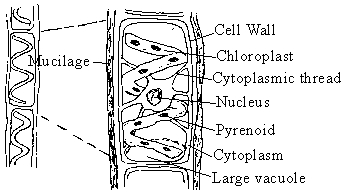
Figure: Ultra structure of Spirogyra
Reproduction in Spirogyra
Spirogyra reproduce by following methods
- Vegetative reproduction: Fragmentation
- Asexual reproduction: Akinete, Aplanospore and Azygospore formation
- Sexual reproduction: Conjugation by zygospore
Vegetative reproduction in Spirogyra:
It take place by fragmentation. It is the common mode of reproduction in spirogyra. Any mechanical damage in the filament or death of some intercalary cell can result in fragmentation. Each fragment bearing few living cell can grow into new filament by repeated cell division.
Asexual reproduction in Spirogyra:
It is very rare mode of reproduction. It usually occur under unfavorable condition where spirogyra produce asexual spores. Two types of asexual spore are formed-Akinetes and Aplanospore.
i) Akinetes: It is a thick walled resting spore formed during unfavorable conditions among some species of Spirogyra such as S. farlowii. When the environmental condition become harsh for the organism then some vegetative cells of the filament lose water get shrunk and rounded. They also deposit thick wall around and act as resting spore. On return of favorable condition, akinete germinate into new filament.ii) Aplanospore: It is a thin walled non-motile asexual spore produced under unfavorable condition by more than 20 species of Spirogyra. Vegetative cell after losing water get rounded up, secrete thin wall around and develop into spore. Single aplanospore formed in single cell. Aplanospore are released after decay of mother filament and germinate into new filament on arrival of favorable condition
iii) Azygospore: It is also known as Parthenospore: In some species such as S.rhizoides, S. mirabilis etc due to physiological condition gametes fail to fuse and behave as spore.
Sexual reproduction in Spirogyra:
It usually occur by zygospore formation conjugation during favorable condition. Conjugation is the process of fusion of two gametes produced by two opposite strain. One strain which donate gamete is designated as male while other one is designated as female. The two gamete produced are morphologically similar and are known as Isogamete. So morphologically reproduction is Isogamous. However, at the time of conjugation male gamete become active and motile and female gamete passive and non-motile, so physiologically reproduction is Anisogamous.
In Spirogyra sexual reproduction is of two type- i) Scalariform: It take place between the cells of two different filaments of opposite strain. At the time of conjugation two opposite strain are attracted toward each other and lie parallel in close contact under common sheath of mucilage. The cell of opposite filament behaves as gamentangia and produce a tubular outgrowth called papillae. The papillae elongates and fused through anterior end with papillae of opposite filament forming conjugation tube. The conjugation tube is hollow structure formed as enzyme cytase dissolve the wall joining the two papillae. Several conjugation tube may appear along the length of filament giving ladder like appearance. So, this conjugation is known as scalariform conjugation. At the same time the protoplast of conjugating cell lose water, accumulate starch and function as gamete. Among two gamete, male gamete is motile and active while female gamete is stationary. Male gamete squeezes through conjugation tube and pass into another filament and get fused with female gamete forming zygote. The zygote produce thick wall around it forming Zygospore. One filament form series of zygospore while other filament become vacant. Zygospore under suitable condition germinate into new filament.
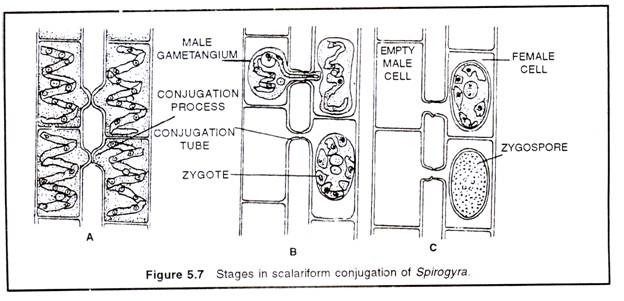
- ii) Lateral conjugation: It occurs between the cells of same filament among homothallic species of Spirogyra. It occur by two methods
- a) Indirect lateral conjugation: In this method, two adjacent cells of same filament develop lateral outgrowth. Due to lateral outgrowth and enzymatic activities the septum between the cells breaks forming conjugation tube. The male gamete moves through the conjugation tube and fused with female gamete forming zygote or zygospore, which develop into new filament.
- b) Direct lateral conjugation: It is primitive type of conjugation occurring in few species. In this type, lower cell of the two adjacent cells get enlarged and form barrel shaped female gamete, while other behave as male gamete. The male gamete develop pointed boring organ which create pore mechanically or enzymatically on middle of the septum. The protoplasm of male gamete migrate through the pore and fused with female gamete forming zygospore which develop into new filament under suitable condition.

Germination of Zygospore in Spirogyra:
- zygospore are thick walled sexual spore. It is a diploid spore and is releases after decay of the female filament. It is a resting spore and resistant to unfavorable environmental condition. Under suitable condition zygospore germinate. Before germination, diploid nucleus of zygote divide meiotically into haploid nucleus. Three of which degenerate and only one become functional. During germination outer wall of spore absorb water swells up and burst exposing inner layer as cylindrical germ tube. The germ tube divides transversall to form two celled structure. Lower cell form rhizoids and attached to substratum while upper cell divides repeatedly to form new filament. The filament get detached from the substratum and become free floating Spirogyra.
